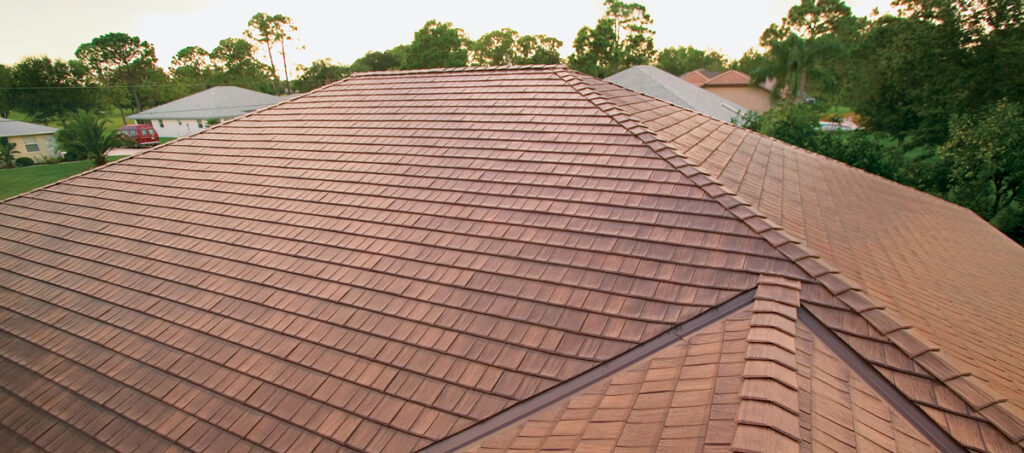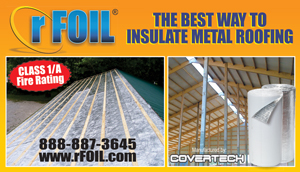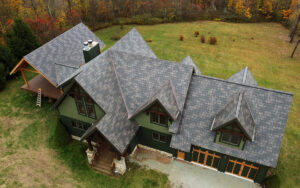There must be something to the look of the shake roof, because almost everyone offers a metal shake facsimile.
That’s the look that is attracting the attention of homeowners, building owners, and architects who also appreciate the benefits of metal roofing. And manufacturers must be paying attention — plenty have jumped onto the shake facsimile bandwagon to arm contractors with the exact shake look they want to offer.
Wood shakes have long been an attractive and popular roofing choice, mainly in the western United States, and not surprisingly, that’s where metal shake facsimiles are most popular. Wood shakes come with drawbacks such as mold, and susceptibility to wind, rain and rot, splitting, infestation, and most significantly, fire. Metal shakes, on the other hand, provide the answer to all of those shortcomings. Because of all those benefits and the aesthetics of today’s modern profiles, metal shakes are opening eyes all over the country, both as aluminum and stone-coated steel.
“It’s mostly seen in California, Oregon, Washington, and Texas, basically anywhere people are used to seeing wood shakes,” says Tony Tiapon, western zone manager for Decra Roofing Systems, a California manufacturer of stone-coated roofing. “People want it because it’s what they’re used to seeing, it’s what they used to see growing up. But if you look in Chicago or other parts of the Midwest, a lot of metal shake is being installed there. I think it’s mainly because it’s different than the asphalt roof they’re used to, but it still blends into a neighborhood with all the benefits of metal.”
Metal Shake Profiles
The most common metal shake profile started as a product used as siding, aluminum siding. It was first used as roofing more than 40 years ago. Alcoa’s Aluminum Country Manor Shake, now owned by Classic Products, was the metal (aluminum) painted shake that really exposed people to how good a shake roof can look even if it’s made from metal.
Today, Classic Products offers a variety of aluminum shake profiles — Wood Shake, Rustic Shake, Country Manor, Timber Creek, and the recently acquired Great American Shake. Classic’s Rustic Shingle is designed to have a rugged texture and deep realistic wood grain to replicate wood shake shingles.
Todd Richards, vice president of marketing, estimates 95 percent of Classic’s business is for residential projects. “Some of our larger dealers have had some success with multi-family projects and several in church buildings,” he says. “We’ve actually done very well with churches. They like the look and they like that they don’t have to worry about replacing the roof again, making that kind of investment.”
Richards says Classic’s products are growing in popularity throughout the nation, but typically have been easier to sell in the South, where metal has a longer and more prominent residential history. He says Texas, Louisiana, and Florida are among the more successful markets for Classic. Also doing well are dealers in Canada, Michigan, New England, and in the Mid-Atlantic states.
“Most of our dealers aren’t roofers, they’re remodelers,” Richards says. “They’re dealing with people investing in their home, doing something to maintain or increase the value. It’s energy efficient with our cool roofing offerings and that’s important in these very unstable times with energy costs. Plus, it really looks great.”







Stonehenge Roofing Products is a relatively new manufacturer in the stone-coated roofing market, making its debut at METALCON in Las Vegas just more than a year ago. One of its original offerings is the Stonehenge Shake, made from 26-gauge Zincalume steel with a lifetime non-prorated warranty.
“Shakes are what’s driving the market right now, especially in the Southwest, Southern California, Nevada, Arizona, New Mexico, and Texas, and in the Northwest, Northern California, Oregon, and Washington,” says Tim Brown of Stonehenge. “That’s where we’re having great success. That’s where people are used to the traditional look of wood shake roofing.”
Wood Under Attack
Wood shake roofing has come under heavy attack in recent years because of its obvious vulnerability to fires. In 2003, Southern California wildfires burned more than .75 million acres and burned more than 3,400 homes. (Metal Roofing, February-March 2004). Many of those homes had wood shake roofs, which caught fire when wind-blown sparks landed on them. Many homes with metal roofs survived because the roofing material didn’t catch fire when exposed to those wind-blown sparks.
Tiapon says for that reason in California, many counties are outlawing the installation of wood shakes. After the aforementioned 2003 wildfires, some insurance companies were canceling homeowners’ policies if their homes had wood shake roofs. “It was good for us, but it’s kind of strong-arming the homeowners,” Tiapon says. “Now it’s a re-roofing product all over California and it’s being used in all ends of the market. It’s not exclusively for high-end homes.”
Other Choices in Weather Vulnerable Areas
Brown says success started for Stonehenge in the re-roofing market, but recently has caught on for new construction, especially in Florida. “In Florida, it’s mainly a lack of availability of other roofing products,” Brown says. “I’ve heard where some suppliers of concrete tiles are taking orders six months out. They can’t fill the orders.”
Stonehenge has manufacturing facilities on the west coast and in Maryville, Tenn. “We’re the first stone-coated manufacturer to have a plant in the East, so we can easily meet the need of our customers there,” Brown says.
Another relatively new product is the KasselWood profile from Kassel & Irons. Constructed of galvanized steel with BASF’s Ultra-Cool Kynar 500 finish, the product meets Energy Star requirements for a cool roof.
“Our shake facsimiles are commonly used in new construction and re-roof residential applications along with commercial projects that desire a nice, traditional look,” says Nick Allen of Kassel & Irons. “The popularity of metal shakes is growing throughout the country, especially in areas that have restrictions on installing wood products because of fire or maintenance concerns. Shake facsimiles are an excellent replacement for virtually every product in the marketplace because of their appealing look and meaningful warranty. And most importantly, they’re very affordable when you consider it from a life-cycle perspective.”
Stone-coated steel shakes came on the scene in the late 1980s. According to Pete Croft at Metro Roof Products, stone-coated manufacturers with roots in New Zealand offered only tile facsimiles. “There’s no cedar trees down under, so the design of the metal shake was not even considered,” Croft says. “The demand came from California contractors who were selling across the state to homeowners who had existing wood shakes on their homes. It seemed a natural fit to sell them a wood shake look versus trying to convince them to use tile that really didn’t suit the architecture.”
Metro opened its California manufacturing plant in 1999, introducing the Settler Shake and then the Metro Pioneer shake. In 2001, the company designed the first nailable battenless shake panel, the Metro Shake II. “It had very defined wood grain patterns and deep key-ways to promote the wood shake look,” Croft says, “but its real success was that it could be installed battenless. A by-product of the Metro Shake-II battenless design was that the deep wood grain pressing shape created an extremely strong panel and combined with the panel being very close to the roof deck once installed to make walking on the roof very easy.”
Croft says the Metro Shake II panel incorporates a built-in stagger pattern, but has two locating points so the panel can be staggered in two different areas across its full width of 50 inches of coverage. “This extra stagger locator point enables installers a little more freedom in the installation process and creates a panel that not only looks good but also was easy to install,” Croft says.
Since acquiring the MetalWorks shingles in 2004, TAMKO has seen a bigger demand for its shake profile. TAMKO’s manufacturing capabilities and distribution centers have allowed the company to meet that demand. Kay Schorzman says the Astonwood, MetalWorks’ shake facsimile, is most popular in the Southwest and Southeast regions of the country.
Wood-Look Metal
“Astonwood has a wood appearance, a wood grain look, stamped into the shingle,” she says. “It’s applicable in any area of the country.” Schorzman says the Astonwood is available in seven stock colors, but custom coloring is offered. She says the two shades of brown, the closest colors to the authentic look of wood shakes, are the most popular, accounting for approximately 45 percent of the Astonwood sales in 2005. In addition to offering the common metal benefits of durability, fire, wind, and impact resistance, the Astonwood is a G90 steel product with a 9 percent zinc coating. “The zinc coating is a rust preventive coating,” Schorzman says. “And the Kynar paints are the best out there for not fading and chalking.”
Metal Shake Options
Al Reid of Dura-Loc Roofing says for installers of metal roofing, offering the shake facsimile is a must and for someone installing metal for the first time, working with shake facsimiles is a great way for a contractor to cut his teeth. “It’s more forgiving, it’s easier to install than the tile profiles,” he says. “The details are easier to work with.”
Reid says most Dura-Loc installers offer both shake and tile facsimiles, but “the good ones know what the customer wants before they walk in the door.” For re-roofing, he says regional preferences influence the choices homeowners make — neighborhoods evolve from one option to another.
“For a long time, the shake profiles came in the darker colors, charcoal, slate, and brown,” Reid says. “Obviously because they looked the most like the new, medium, and older wood shakes. Today, we’re using it as a replacement for concrete tile, especially in the extreme climates where tile doesn’t hold up as well.”
Traditionally, tile roofing has been installed in brighter and lighter colors, colors that don’t replicate the look of wood shakes. Manufacturers will give the customers what they want.
Still, metal shakes are strongest where wood shakes were the traditional or popular choice.
“The biggest market still is California,” says Pat Barton, director of marketing for Gerard Roofing Technologies. “The replacement of wooden shake roofs has been the biggest market for us. In a lot of areas, the wood shakes are failing. Our product, a lot of people like the profile, it’s similar to the wood shake. It has deep grooves and it’s walkable.”
Barton says the Gerard Canyon Shake is a 2-year-old product, but has taken off in sales because of its look and the growing metal market as well as the desire for the shake products.
Manufacturers are answering the demand for metal shake, always making it look better for the building owner or architect and making it easier to install for the contractor. MR






















